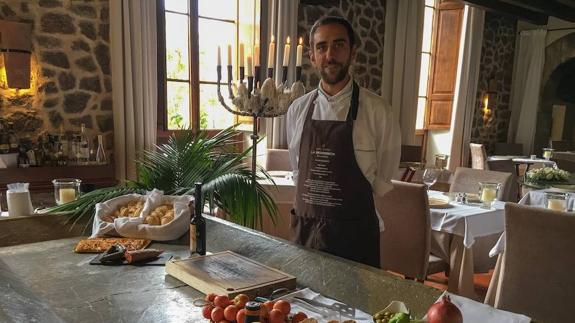Bread with oil - understanding Mallorca
This classic Mediterranean dish offers an insight into the culture and history of this Balearic island
Andrew Forbes
Martes, 17 de enero 2017, 10:48
Worn smooth through years of use, the immense table in the centre of the room had a softness to it that belied its obvious weight and size. Hewn from huge pieces of rock, it was once used to crush the local harvested olives before pressing, but now served as a generous work surface for young Mallorca chef Nicolás Cambón.
To one side is a bottle of oil, and a shallow wooden crate of aged tomatoes, with a subtle waxy patina; beside which sits a wooden tray of rustic bread, and tubs of Mallorca sea salt.
Pa amb oli
Placing the slices on the board in front of him, the chef began drizzling the bread with local olive oil, pressed in nearby Soller. Nicolás is creating a classic Mediterranean dish, bread with olive oil; yet here in Mallorca 'pa amb oli' as it is known, has become iconic of the island's culture and history.
I'm in the 'El Olivo' restaurant of Belmond's La Residencia, above the quintessential Mallorcan village of Deià; a place of charming stone built properties, in the foothills of the Tramuntana mountains. This popular destination is home not only to wealthy residential tourists but also to artists, musicians and writers too. The village was the home of Robert Graves, the English novelist and poet. Earlier in the day I had been gifted a copy of his son's book 'Bread and Oil' in which Tomás Graves explores this simple island dish to better understand Mallorca, the island's culture and its rich history over millennia; and it whetted my appetite to discover more.
Once used as the estate's olive mill, this cavernous space has been converted into an elegant dining room, with tables positioned amongst the ancient mill paraphernalia, including the large stone table where the chef is now cutting the plump, aged tomatoes in half, revealing their generous pulp. By simply rubbing them against the course rustic bread, the tasty tomato becomes a colourful topping.
Experiential
Mallorca has long been a favourite amongst northern Europeans for its stunning pine-clad mountainous countryside, and those crystalline coves and bays, images of which can swiftly transport us from the mundane to an escapist world of tranquillity. Yet increasingly the island's package tourism is becoming an anachronism; holidays of just sun, sea and sand offer little insight into the culture or history of Mallorca.
Yet by immersing oneself into a homespun ritual such as this, the preparation of a local dish, one becomes somehow more connected, more in tune with the place.
Experiential travel is nothing new, but hotels and resorts are increasingly creating experiences that help their guests engage with a destination and come away after a relaxing holiday with more than just a glowing tan or lower blood pressure, but a better understanding of where they have been.
Aztec tomatoes
The ramallet tomatoes used in this humble recipe are also regarded as part of Mallorca's living history. This unusual type of hanging tomato, or 'tomatiga de penjar' can be traced back to the earliest types of tomato introduced to Spain and the rest of Europe thanks to expedition to the New World. Harvested in late summer, the ramallet are carefully strung together by hand, and hung in a cool, dry environment to age gently over many months. Bread and oil is a dish that reflects a time before modern food preservation. These specific tomatoes retain their plumpness throughout, yet their flavour intensifies, with a delicious sweetness.
Liquid gold
The oil is another of the island's prized products and an integral part of the agricultural and social history of Mallorca. This mountain area of the Tramuntana has UNESCO world heritage status, not only for its stunning scenery, but for its unique way of life, one that is connected to the land, to the seasons. Productive olive trees were brought to Iberia and her islands by the Phoenicians and Romans and further cultivated by the Arabs. According to Tomás Graves' book, Mallorca's liquid gold became the island's greatest export from the fifteenth century. Indigenous oak forests were cleared and the land terraced to maximise space for the groves. From the restaurant terrace of La Residencia one can still see the twisted, ancient olive trees, some hundreds of years old.
The Mediterranean kitchen is celebrated for its health properties, but all too often modern interpretations and processes, together with less than genuine ingredients offer us a poor substitute. Going back to basics is a way to experience the real thing; home baked bread, local aged tomatoes and island olive oil and you have the authentic flavours of Mallorca.
Flor de Sal
That's not all though - anyone familiar with Mediterranean food will know the importance of salt. Here on Mallorca salt has been part of the island's history and culture since the times of the Romans and Phoenicians. Head to the Es Trenc-Salobrar National Park in the south of the island and one discovers an extraordinary wetland area of beautiful protected beaches. At the end of the wetlands are the salt flats - an otherworldly landscape of salt ponds, evaporating sea water bumped up from the beach. Some 10,000 tons of salt is said to be produced each year; and often these delicate salt flakes are enriched with the Mediterranean flavours of the island; so expect tomato of course, black olive, but also rose and hibiscus versions. This gourmet 'Flor de Sal', an aromatic mineral rich salt, is the final touch for a classic 'pa amb oli'. Travel across the Mallorca and you see various additions to bread with oil that reflect local tastes, including figs, cured ham, capers and rock samphire, the sea fennel that is still harvested on the north west coast. So, next time you visit Mallorca, savour this classic island dish.
¡Bon Profit!
